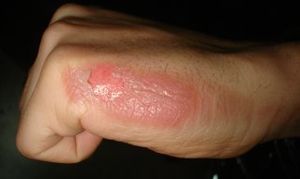Burn injury
| Burn | |
|---|---|
 |
|
| Second-degree burn of the hand | |
| Classification and external resources | |
| Specialty | critical care medicine |
| ICD-10 | T20–T31 |
| ICD-9-CM | 940–949 |
| DiseasesDB | 1791 |
| MedlinePlus | 000030 |
| eMedicine | article/1278244 |
| MeSH | D002056 |
A burn is a type of injury to skin, or other tissues, caused by heat, cold, electricity, chemicals, friction, or radiation. Most burns are due to heat from hot liquids, solids, or fire. Females in many areas of the world have a higher risk related to the more frequent use of open cooking fires or unsafe cook stoves. Alcoholism and smoking are other risk factors. Burns can also occur as a result of self harm or violence between people.
Burns that affect only the superficial skin layers are known as superficial or first-degree burns. They appear red without blisters and pain typically lasts around three days. When the injury extends into some of the underlying skin layer, it is a partial-thickness or second-degree burn. Blisters are frequently present and they are often very painful. Healing can require up to eight weeks and scarring may occur. In a full-thickness or third-degree burn, the injury extends to all layers of the skin. Often there is no pain and the burn area is stiff. Healing typically does not occur on its own. A fourth-degree burn additionally involves injury to deeper tissues, such as muscle, tendons, or bone. The burn is often black and frequently leads to loss of the burned part.
Burns are generally preventable. Treatment depends on the severity of the burn. Superficial burns may be managed with little more than simple pain medication, while major burns may require prolonged treatment in specialized burn centers. Cooling with tap water may help pain and decrease damage; however, prolonged cooling may result in low body temperature. Partial-thickness burns may require cleaning with soap and water, followed by dressings. It is not clear how to manage blisters, but it is probably reasonable to leave them intact if small and drain them if large. Full-thickness burns usually require surgical treatments, such as skin grafting. Extensive burns often require large amounts of intravenous fluid, due to capillary fluid leakage and tissue swelling. The most common complications of burns involve infection.Tetanus toxoid should be given if not up to date.
...
Wikipedia
